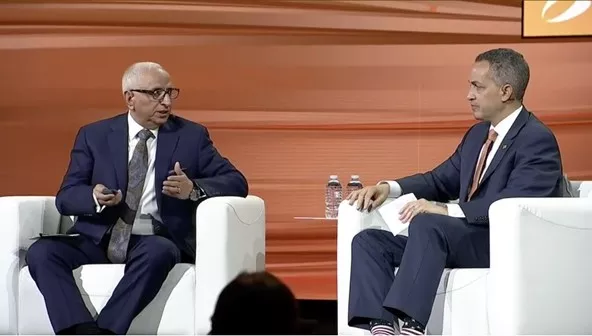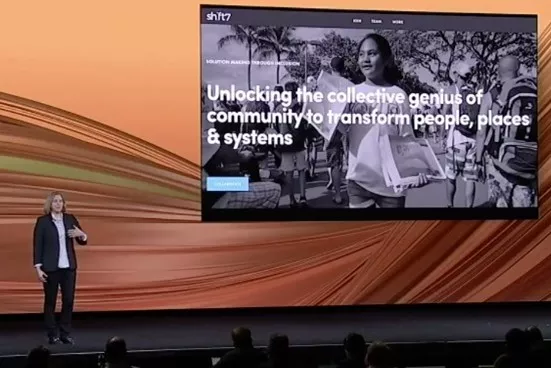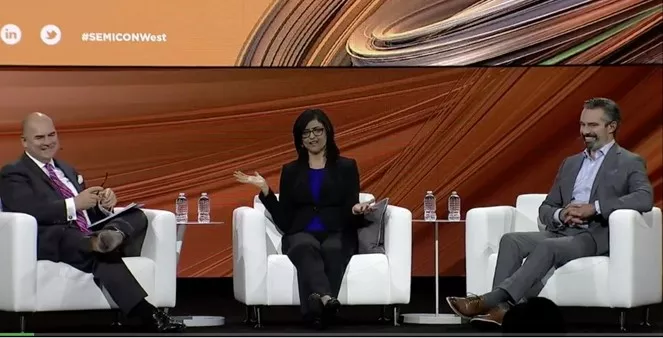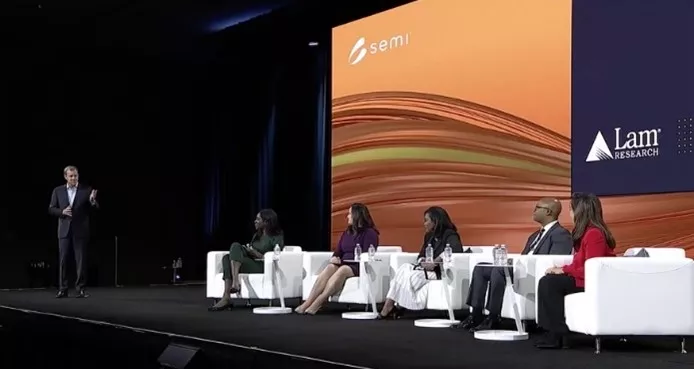Continuing the SEMICON Sprint to 2022, collaboration, transparency, and diversity were prominent themes echoed by industry leaders at SEMICON West 2021 Hybrid as the microelectronics industry works to make the most of the current boom and to manage crises and opportunities around the chip and talent shortage, data explosion, compliance requirements, digital innovation, environmental sustainability, remote work, and other pressing issues.
After a two-and-a-half-year hiatus from the on-site gathering, thousands gathered last week at San Francisco’s Moscone Center and online for the hybrid exposition. Participants seized the moment by exchanging insights on the latest trends and attending nearly 200 executive and expert presentations on Smart Manufacturing, Smart Mobility, Smart MedTech, Workforce Development, Data-AI and Flexible Electronics Innovations.

Dave Anderson, president of SEMI Americas
“We’ve adapted to more change in the past 24 months than ever before,” David Anderson, president of SEMI North America, said in his welcoming remarks with themes from The Matrix. “As always, with change comes an abundance of opportunities as our markets continue to grow and transform. Perhaps this is the Darwinian Moment for our industry. But as Darwin said, ‘It’s not the fittest that survive but the most adaptable.’ And we really are adaptable.’”
Following are takeaways from SEMICON West 2021 Hybrid that demonstrate the extraordinary ability of the global electronics design and manufacturing supply chain to adapt.
Unprecedented Partnership with Government Poised to Pass $52 Billion CHIPS Act
Kicking off the keynotes and panel discussions at SEMICON West, Ajit Manocha, SEMI president and CEO, noted heightened awareness of the critical leadership role played by the chip-making industry to secure the future of the U.S. digital economy. In a Fireside Chat, Manocha and U.S. Deputy Secretary of Commerce Don Graves spotlighted today’s “unprecedented” alliance among SEMI, government leaders, and the extended microelectronics design and manufacturing supply industry.
“Now is the most important time for us to be communicating and collaborating,” said Graves. “We really are at an inflection point in the global economy and the development of the semiconductor industry. It’s not just about fabs but the entire ecosystem. We know for our economic security that we must work collaboratively to do enough to support the forward development and forward innovation of your industry.”

Ajit Manocha, president and CEO of SEMI, with Don Graves, U.S. Deputy Secretary of Commerce
Noting the U.S. share of global semiconductor manufacturing has eroded from 37 percent to 12 percent since 1990, Graves expects funding for the CHIPS for America Act, which would pump $52 billion into domestic semiconductor production, design, and innovation, to be approved soon. He urged the entire supply chain ecosystem to transparently help prioritize and balance investment goals that build a “healthy and resilient” industry without compromising confidentiality.
U.S. Senate Majority Leader Charles Schumer and U.S. Sen. Gary Peters (MI) beamed in strong messages that they too realize the strategic importance of chips to the U.S., and both are prioritizing legislation – including the CHIPS Act and bills that buttress infrastructure, provide investment tax credits and manufacturing incentives – that fuels semiconductor industry growth.
Tapping Our Collective Genius
In her keynote, Innovation Nation – How to Creatively Source and Accelerate Solutions to Our Most Significant Challenges, Megan Smith, 3rd U.S. Chief Technology Officer and CEO of shift7, said that digital solutions to the semiconductor industry’s and society’s most pressing problems – from air and water quality to sustainable manufacturing – probably already exist and can be replicated. From grade schoolers in Oklahoma prototyping a page-turning robot to local talent creating a floating fabrication lab on the Amazon River, problem solvers can do more to expand their search for local innovations they can adapt and scale by tapping into the “collective genius” of different peoples, industries, and skill levels.

Megan Smith, 3rd U.S. Chief Technology Officer and CEO of shift7
“In the age of AI, we need to talk more about human intelligence” and the significance of diverse teams while taking fresh looks at unconscious bias built into algorithms, Smith said. “We have to get better at telling the story of the whole team and not just heroizing the founders. It was really the whole team working together in the original development of the Mac – not just Steve Jobs.”
Future Risks and Threats to Supply Chain Security
In a discussion moderated by Raymond Kerins, Chief Executive Officer of The Next Solutions Group, panelists stressed that chipmakers and their multi-tiered ecosystems must embrace greater transparency, collaboration and diversity to help each other survive a rising tide of risks threatening supply chains. And at a time when too many container ships sit idle offshore and store shelves remain bare, industry leaders must take a fresh and holistic look at key aspects of their supply chain’s health such as cybersecurity, factory or delivery capabilities, regulatory compliance, sustainability, pricing, and financial stability.
“There are plenty of ways (for manufacturers) to engage with a supplier to help them (overcome a risk), but it starts with transparency and collaboration,” said James Gellert, Chairman and CEO of RapidRatings. “Transparency is one of the three biggest topics of the last five years.”
“If a supplier tells you they’re going into bankruptcy, then it’s too late,” added Bindiya Vakil, Founder and CEO of Resilinc. “But once the health of a supplier is known, then it opens you up to a whole bunch of possibilities for risk mitigation.”

(L-R) Raymond Kerins, Chief Executive Officer of The Next Solutions Group; Bindiya Vakil, Founder and CEO of Resilinc; and James Gellert, Chairman and CEO of RapidRatings
Gellert agreed, noting that “Risk in the supply chain isn’t about limiting or eliminating the source of risks, but it’s about managing them better together.” Small-, minority-, and women-owned suppliers that are “hungry for business” tend to demonstrate collaborative trust, so are more apt to share sensitive information and creatively align their operations, Vakil said. “It might seem like a bigger risk (partnering with smaller suppliers) in the near term, but long term you will be more successful.”
From large manufacturers to small suppliers, the entire ecosystem must more precisely map supplier and sub-tier supplier operations end-to-end and share the information with partners and customers. Vakil and Gellert also cautioned that smaller suppliers in particular are overwhelmed responding to a rising tsunami of information requests on myriad compliance issues. However, Vakil said, that challenge also presents “a huge opportunity for SEMI to represent both sides” to standardize and simplify these requests for information.
Advancing Connection: The Future of Collaboration
Amidst COVID-19’s many uncertainties and disruptions the past two years, KLA has logged record growth by adhering to long-time principles and values while swiftly adjusting to the pandemic’s changing realities.
“The things we have always done didn’t change but how we do them now has changed,” Rick Wallace, KLA president and CEO, said while sharing lessons learned. The company’s five operating models – performance, drive to be better, high-performance teams, honesty, forthrightness, consistency; indispensability to customers – guided its way forward as it implemented extraordinary measures to help safeguard it employees, operations and facilities.

Rick Wallace, KLA president and CEO
For example, global investments in manufacturing, research and development didn’t flag while some even accelerated. At the same time, KLA rerouted travel funds to help beef up tech support and home offices for remote workers, enhance cybersecurity protections, and create no-touch online labs where developers could innovate products with virtual 3D models and goggles. Wallace also credited online collaboration tools as well as “frequent and transparent communications” from the top to reinforce best safety practices, new flexible work plans – especially for women with families – and business updates for all its constituents.
Two Business Imperatives: DEI and Sustainability
To thrive in the future, companies throughout the global semiconductor supply chain must build more diverse workforces while driving toward more sustainable operations to conserve natural resources and reduce their carbon footprint – imperatives that are inextricably intertwined. Multiple keynote speakers and panelists highlighted that an increasingly powerful and broad cross-section of microelectronics industry stakeholders – from government policy makers to customers and financial institutions – demands meaningful progress on both the diversity, equity and inclusion (DEI) and sustainability fronts. Millennials, a key demographic the industry is targeting with its workforce development initiatives, will comprise about 75% of the U.S. workforce by 2025, and the vast majority want to work in environments valuing diversity and sustainability.
Studies increasingly find that DEI-focused cultures help fill the rapidly widening STEM skills gap by hiring from a larger talent pool and are more effective in minting new innovations, said Tim Archer, president and CEO, Lam Research.

Tim Archer, president and CEO of Lam Research, moderates the panel Building the Workforce of the Future: The DEI Imperative
Setting the stage for an expert panel on Building the Workforce of the Future: The DEI Imperative, Archer said Lam wants to attract and retain more diverse talent by considering new benefits – such as tuition reimbursement, student loan payments, and extended parental leave – to build on the existing DEI program of rotating highly educated employees in different roles companywide.
The panelists urged companies to cultivate workplaces that welcome and value varied perspectives, tailor work plans to each individual’s strengths and needs, communicate clear paths for promotion, raise awareness about unconscious bias, and provide upskill training at all levels. Participants included Katherine Dei Cas, SVP, Global Head of Delivery Systems & Service at EMD Electronics; Antoinette Hamilton, Global Head of Inclusion & Diversity at Lam Research; Brennon Marcano, CEO of National GEM Consortium; and Lareina Yee, Senior Partner at McKinsey & Company.
Other industry speakers underscored the vital importance of DEI in a panel discussion and a podcast recorded from the show floor as part of the SEMICON West 2021 Hybrid podcast series from 3D InCites.
To help accelerate the microelectronics industry’s response to the climate crisis, the new SEMI Sustainability Initiative driven by members provides a common framework to tackle environmental issues. “It’s really time to get serious about sustainability and show our industry is part of the solution and not part of the problem,” said James Amano, senior director of SEMI International Standards and EHS as he discussed the program.
Partnering with McKinsey & Company, SEMI has established a Sustainability Advisory Council and plans to expand its standards working groups to develop sustainability roadmaps concerns for semiconductor manufacturing in areas such as heating, cooling, emissions, waste, water conservation, energy efficiency, and decarbonization. SEMI CEO Ajit Manocha also addressed the importance of sustainability in a 3D InCites podcast recorded at the show.
The SEMICON Sprint to 2022 Continues
There is still time to access SEMICON West 2021 Hybrid. On-demand presentations, virtual exhibit booths, and other content are available until January 7, 2022. Register Now!
Next up on the SEMICON Sprint to 2022 is SEMICON Japan 2021 Hybrid in Tokyo, December 17-19. For those not attending in person, there’s still time to register for the virtual program.
Julie Rogers is Director of Marketing for SEMI Americas.